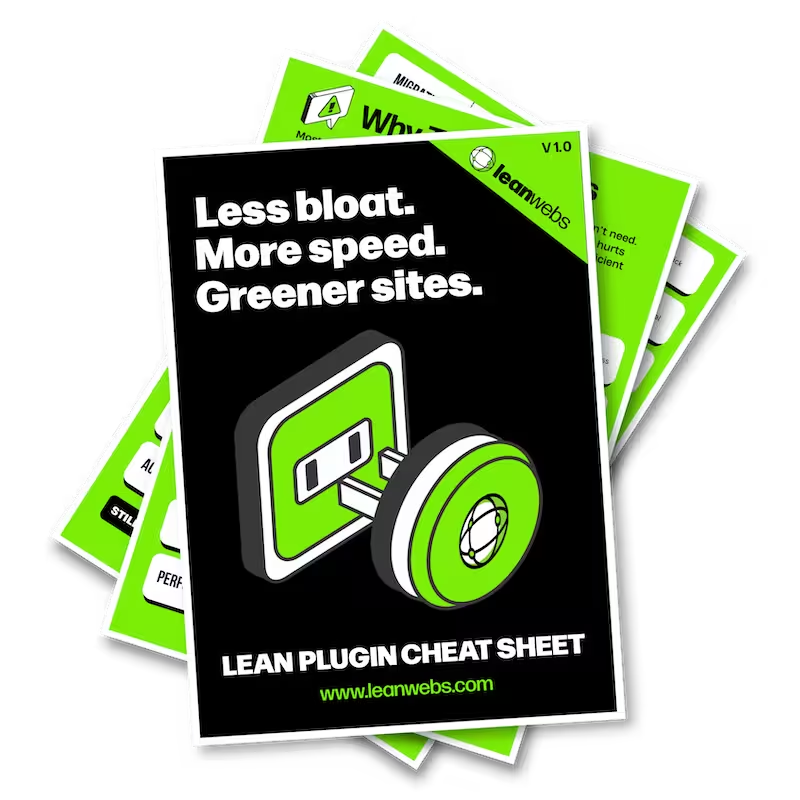Switching to system fonts is one of the fastest ways to cut load time, remove third-party requests, and reduce your site’s carbon impact. Unlike Google Fonts, system fonts are already installed on your users’ devices, meaning zero downloads, zero tracking, and instant text rendering.
Here’s how to make the switch in WordPress, along with the performance and sustainability wins you can expect.
Why system fonts load faster (and cleaner) than Google Fonts
Google Fonts add extra HTTP requests and often delay how quickly your content becomes readable. Every time a user loads your page, their browser may fetch fonts from Google’s servers, increasing TTFB (Time to First Byte) and affecting FCP (First Contentful Paint) and LCP (Largest Contentful Paint) scores.
System fonts, by contrast, are built into every major operating system. They load instantly and don’t shift layout as they render (no FOIT or FOUT issues). They also avoid third-party trackers and simplify GDPR compliance.
In one test, switching from Google Fonts to a system stack shaved ~200ms off mobile load time and eliminated 2 external requests (EcoPing, 2025).
- Faster performance
- Better privacy
- Lower carbon load
Learn more: How web hosting affects speed and CO₂ output
The Quick Fix for a Slow, Heavy Site
We optimise your site for speed, efficiency and sustainability. No rebuild. No delays. Just better performance and a lighter footprint.
What system fonts look like across devices
Modern system font stacks are designed to match each OS’s native look. Here’s a widely used example:
font-family: -apple-system, BlinkMacSystemFont, "Segoe UI", Roboto, "Helvetica Neue", Arial, sans-serif;This stack means:
- Apple users see San Francisco (
-apple-system) - Windows users see Segoe UI
- Android users see Roboto
- Everyone else falls back to Arial or another sans-serif font
These fonts feel clean, familiar, and trustworthy. They also reduce layout shifts caused by font swapping, helping you pass Core Web Vitals.
Want a side-by-side preview? This visual demo by Modern Font Stacks shows how different system fonts appear across platforms.
If your brand relies heavily on custom typography, consider pairing a minimalist system stack for body text with a carefully chosen heading font, but self-host it to avoid the same performance pitfalls.
How to replace Google Fonts with system fonts
1. Check your theme settings
Some WordPress themes (like Astra, GeneratePress, or Blocksy) let you select system fonts under Customise > Typography. Look for options like:
- “System stack”
- “Default system font”
- “Inherit browser font”
2. Disable Google Fonts loading
If your theme still loads Google Fonts, install one of these plugins:
- OMGF – lets you replace or disable Google Fonts entirely
- Disable Google Fonts – lightweight and effective for many block-based themes
These prevent background requests to fonts.googleapis.com and fonts.gstatic.com.
3. Override with custom CSS
Add this under Appearance > Customise > Additional CSS:
body {
font-family: -apple-system, BlinkMacSystemFont, "Segoe UI", Roboto, "Helvetica Neue", Arial, sans-serif;
}This ensures your entire site uses fast, local system fonts, even if your theme doesn’t offer font control directly.
Measure your gains: speed, stability and CO₂
Before and after switching, test your site with:
- EcoPing – carbon and performance metrics
- Website Carbon Calculator – estimates grams of CO₂ per view
- Google PageSpeed Insights or Lighthouse – to check LCP, FCP, CLS
Look for improvements like:
- −200 ms load time
- −2 to 3 external requests
- 5–8% reduction in carbon footprint per page (EcoPing estimate)
Here’s an example from a simple WooCommerce homepage:
- Before: 1.8s LCP, 6 font requests, 0.48g CO₂/view
- After: 1.2s LCP, 0 font requests, 0.34g CO₂/view
Try it and see the difference
System fonts are a low-effort, high-impact change that boosts speed, privacy, and sustainability. In most cases, you can make the switch in under 10 minutes.
Try it out. Run your tests. And if you’re hitting roadblocks, you may be due for a leaner theme. Learn when a rebuild is worth it.
Advanced font stack tips:
- Add
font-display: swap;to avoid invisible text on slow connections - Use
@font-faceonly if self-hosting specific brand fonts (WOFF2 recommended) - Example fallback:
@font-face {
font-family: "YourBrandFont";
src: url("/fonts/yourbrandfont.woff2") format("woff2");
font-display: swap;
}Why not just self-host Google Fonts? You could, but system fonts are simpler, lighter, and faster to deploy. Self-hosting adds maintenance and still won’t beat native OS fonts for speed.
Next steps
- Run your site through EcoPing or PageSpeed Insights
- Explore more quick wins in the Toolkit
- Tweak your theme or plugin setup to remove unnecessary font requests
Every byte counts. Start lean here, then build up responsibly.



